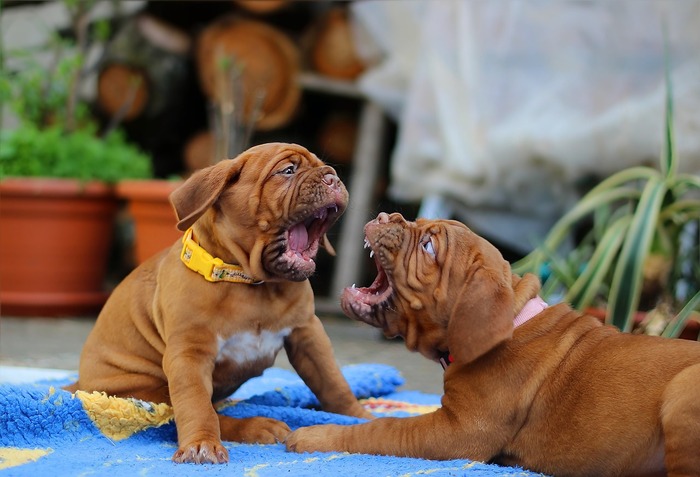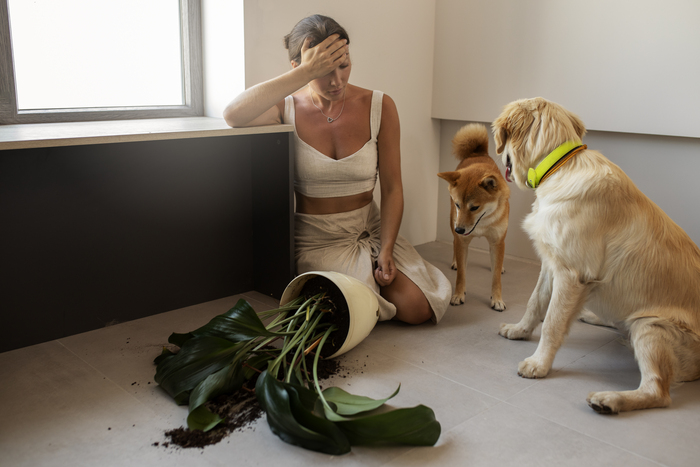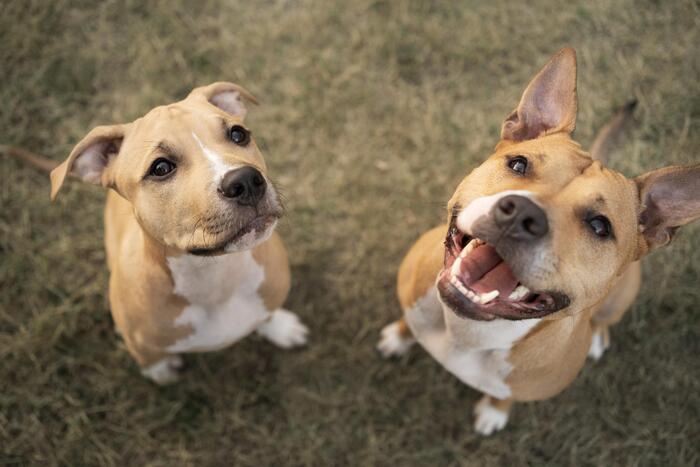2023-06-05
Let’s be honest- raising a dog can become a very challenging task that requires our full commitment and plenty of time. In the end, that is of course a very rewarding experience, and we can see the fruits of our efforts- a strong emotional connection, unconditional love, and a lifetime companion!
However, raising a dog is a responsibility that not all of us want or are ready to bear, not to mention raising multiple dogs in the same household. Being a pet parent of more than one dog is related to many joyful and funny moments, but also to challenging tasks to deal with, such as how to stop them from fighting.
If you are raising multiple dogs in your home, who do not get with each other and tend to fight, this article may provide you with helpful tips on how to handle the situation.

In order to address fighting as a behavioral issue, you should know what the cause of this behavior may be.
You may have rushed the process in case you wanted our paw friends to meet and hit it off immediately. If you just brought your dogs together or brought one of them to the other one’s personal area, this is likely to have caused conflicts.
If you want your paw family members to get along with each other, you should try to introduce them to a neutral area like a park or another area, that they do not perceive as “their territory”. Allow them to sniff each other and get used to each other’s presence.
It is recommended that you supervise the interaction while both dogs are on a loose leash. Keep in mind, that introducing two dogs while on a short leash can increase the tension and lead to stress or aggression.
You may need to ask a third party for help so that you can lead one of the dogs and the other person can handle the second dog during the process of introduction. It is advisable that you opt for someone who has previous experience with walking and handling your dog, so your paw friend feels comfortable.
If your dogs remain calm and playful, reward them for showing the desired behavior.
Socialization is an essential part of every dog’s process of growing and becoming a mature and well-mannered family member. Making your dog a well-behaved member of your family, will help ensure their social skills in public.
Socialization should start at а young age when dogs’ abilities to learn new tasks and skills are most effective. Socializing the dog means gradually exposing them to various environments, other animals, and people, so they get used to being in different situations. This will help desensitize any possible triggers in the environment.
The bigger the experience of your paw friend is in dealing with different types of situations, the better the chances are for them to know how to behave appropriately.
Resource guarding is a common behavioral issue in dogs. The term “resources” can encompass not only their food and water, but also their toys, personal area, and their owners too.
That is why we would highly recommend that each dog in your household has their own personal spot, separate food/water bowls, and toys. Also, you should consider their individual needs and take time to walk them, play with them, train them, or otherwise engage in various activities with them. Do not neglect one of your dogs because of the other one.
This term is more generalized and refers to the living conditions of your dog, their socialization, their needs for mental and physical stimulation, and also how you treat them in general. Dogs who lack attention, exercise, mental stimulation, and opportunities to spend their energy, may develop behavioral issues, including aggression towards other pets in the household or outdoors.
We’ve decided to list this factor last, as it is the way we raise and treat our dogs that affects their behavior when they become adults.
You should get informed about the dog’s parents (their health and behavior) prior to getting one. This will help you get aware of any health or behavioral issues your paw friend may be prone to.

Each of your paw friends needs to have their own area at home, where they can rest and relax undisturbed. This will help them not fight for territory, but enjoy their personal space.
This can be very helpful in situations when the dogs need to be physically separated until they get accustomed to each other’s presence.
Do not put your dogs in living conditions where they need to compete for food, water, or other types of supplies such as toys, and bedding. Otherwise, they may feel aroused and competitive toward each other, which can easily lead to fighting.
Try to understand what types of personalities your paw friends have and what factors in their environment could possibly trigger them. Remove any stimuli that may cause tension, or possessiveness, especially during play or feeding times.
Make sure to always supervise your dogs while interacting with each other until they get accustomed to each other’s presence. If you have to leave them home alone, it is advisable that they are in separate areas.
Take time to exercise, walk, train, and play with each dog, so they do not have to fight for your attention.
You may need to spend some additional time engaging in various activities with each of the dogs and gradually introduce them to joint outings. Mentally stimulating toys and games such as puzzles, chase, and chew toys, give dogs opportunities to have a fun time, while spending any excess energy they may have, improving their physical health and problem-solving skills.
Through conducting training (separate sessions in the beginning) your canines will learn basic obedience and how to remain calm and well-mannered. Extended basic obedience will also contribute to improving the skills of your dogs to remain focused on you and ignore all potential stimuli in their surroundings, whether these are other animals, people, sounds, or smells.
Basic obedience will help your canines become more disciplined, calm, and able to handle various situations.
Depending on the time and work you can invest, you can either train your dogs yourself (with the help of a training program) or have them trained by a professional.
If your paw friends have similar interests, such as accompanying you during jogging or hiking, you can use this opportunity to have both dogs together while engaging in something pleasant. Of course, you should make sure that are restrained so that no tension will occur. Also, the help of a third party may be needed to handle one of the dogs while on the outings.
Gradually, you can let the dogs reduce the distance between them, depending on their response.
Annual checkups, vaccinations, and parasite control are mandatory for all responsible dog owners. However, in terms of dog fighting, a veterinarian examination will help you determine whether there is an underlying health condition that may arouse your dog and cause them to show unwanted behaviors such as reactivity and aggression.

These two approaches have proved extremely helpful in dog training, especially if the effect of certain triggers needs to be alleviated and the general attitude of a dog towards a stimulus needs to be changed.
By gradually increasing the intensity of the stimuli while starting at a very low level, you can help your canine get used to them. This won’t happen immediately and will need practice and patience.
Counter conditioning is usually used together with desensitization and is related to providing the dog with a pleasant experience when the stimuli are present. If the dog starts pairing a trigger with something positive like food or toys, they are likely to change their attitude over time.
It is recommended that counter-conditioning is applied to situations when the triggers are not frightening to the dog. If this is the case, by pairing positive reinforcement tools like food or toys with a frightening trigger, the dog may develop a negative attitude toward these tools.
We will list below several simple steps you can follow to change your canines’ attitude toward each other and help them get along with each other.
Have one of the dogs on a leash while the other one is also on a leash, handled by a third party (a relative or a friend);
Based on your dogs’ personalities, determine the distance at that they feel comfortable being from each other without showing reactivity;
Identify what motivates them the most. If they are food-driven, it will be easier or you to reinforce the wanted behavior. You need to prepare their favorite treats and give them these as a reward when they see each other at a comfortable distance. The treats should be of a high-value (at least at the beginning of the sessions) such as pieces of chicken, turkey, string cheese, or other delicious treats that you are less likely to provide outside the training sessions;
Practice the steps listed above several times;
Gradually increase the time duration before you feed the dogs treats;
Gradually decrease the distance between the dogs;
In the beginning, you or the third party, handling the second dog, can start moving by keeping the same distance.
Remember that if you notice any of the dogs becoming agitated, you should decrease the intensity of the stimuli immediately by taking a few steps back or ending the session if needed. Wait a few minutes for the dogs to be calm and relaxed before you continue.
Increase intensity further by having one of the dogs move back and forth and show certain types of behaviors;
Repeat this with the other dog;
Return to the initial distance threshold and increase the level of interaction step by step.
Allow both dogs to move more freely by decreasing the distance gradually. Reward the dogs with each step closer. Continue this process until the dogs are able to remain calm within six feet of each other while moving comfortably and being rewarded with high-value treats.